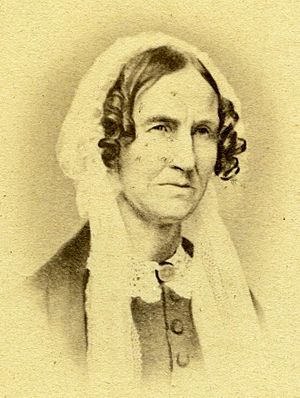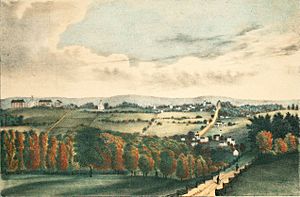Orra White Hitchcock facts for kids
Orra White Hitchcock (born March 8, 1796 – died May 26, 1863) was an important American artist and illustrator. She was one of the first women to create scientific and botanical drawings. Orra is most famous for illustrating the scientific books and lectures of her husband, Edward Hitchcock, who was a geologist. However, she also did a lot of her own amazing art and science work.
Contents
Early Life and Education
Orra White was born into a wealthy farming family in South Amherst, Massachusetts. Her parents were Jarib and Ruth Sherman White. She learned from a private teacher and attended two "ladies" schools. Orra was a very talented child. She was good at many science and classical subjects. She also showed early skill in drawing and painting.
From 1813 to 1818, she taught young girls at Deerfield Academy. She taught them natural sciences, fine arts, and decorative arts. Her early training helped her become skilled in both science and art. People have called her the "earliest and most often published woman artist" from the Connecticut River Valley area.
Marriage and Scientific Art
On May 31, 1821, Orra White married Edward Hitchcock. He was the principal of Deerfield Academy. Later, he became a minister, a professor, and the third president of Amherst College. Orra's art was a very important part of her husband's work.
She drew hundreds of pictures for Edward Hitchcock's science books. These included detailed landscapes of the Connecticut River Valley. She drew these for his geological surveys of Massachusetts. She also designed special charts for his classroom lectures. These charts showed his new discoveries.
Besides this, she made detailed drawings of local flowers and grasses. She also painted small, precise watercolors of local mushrooms. Her work shows us what the scenic, plant-filled, and geologically diverse Connecticut River Valley looked like long ago. Orra White Hitchcock was also a scientist herself. People at the time thought she was one of the valley's "most distinguished naturalists."
Painted Plant Collections
Between 1817 and 1821, Orra and her husband collected local plants. They put them into a traditional plant collection, called a herbarium. At the same time, Orra created a special album. It had 64 pages of watercolors of about 175 local flowers and grasses. She called this album Herbarium parvum, pictum. You can find this painted plant collection in the Deerfield Academy Archives.
In the summer and fall, she also made a small watercolor album of local mushrooms and lichens. She named it Fungi selecti picti. Edward Hitchcock helped by labeling and organizing the specimens. This painted album is kept in the Smith College Archives. A copy of it has been published by the Mortimer Rare Book Collection at Smith College.
Drawing Landscapes and Geology
Hitchcock created drawings for over 200 plates and 1,000 wood-engraved pictures. These were used in Edward's professional books. Her drawings showed landscapes, layers of rock (geologic strata), and different specimens. Her most famous drawings are in her husband's important books. These include the 1833 Report on the Geology, Mineralogy, Botany, and Zoology of Massachusetts. She also contributed to the 1841 Final Report, which he made when he was the State Geologist.
For the 1833 book, a company called Pendleton's Lithography in Boston used a printing method called lithography. They printed nine of Hitchcock's Connecticut River Valley drawings as plates for the book. In 1841, another company, B. W. Thayer and Co., printed updated lithographs and an extra plate. The hand-colored plate called "Autumnal Scenery. View in Amherst" is her most often seen work.
Drawings for Classrooms
From 1828 to the 1840s, Hitchcock made many large and impressive classroom charts. These charts showed things like:
- Geological cross-sections (how layers of rock look underground).
- Prehistoric animals like the Megatherium (a giant ground sloth).
- Fossils.
- Ichnological (later called dinosaur) footprints.
She copied scientific pictures from other books. She also made original drawings of her husband's new ideas or discoveries. An example is Ornithichnites, which were early dinosaur footprints. Edward Hitchcock said her drawings were "indispensable aids" for his lectures. The Amherst College Archives and Special Collections has a large collection of these classroom charts.
Other Contributions
Hitchcock's first known published drawing appeared in 1818. It was for an article written by her husband in a magazine called Port Folio. Sometimes, she also created illustrations for other scientists. Her last known work was symbolic drawings for her husband's book, Religious Lectures on Peculiar Phenomena in the Four Seasons. These included a picture of spring and a colorful rainbow.
Orra White Hitchcock raised six children who survived. She taught them art and science. She was also a true partner to Edward Hitchcock in his scientific projects. She traveled with her husband in the United States and to England and Europe in 1850. She was the mother of two famous sons:
- Geologist Charles Henry Hitchcock (1836–1919).
- Physical education and hygiene pioneer Edward Hitchcock, Jr. (1828–1911).
Edward often thanked his wife for her important help. In his book The Religion of Geology, he said her drawings were even more powerful than his writing.
Orra White Hitchcock passed away at age 67 on May 26, 1863, from consumption.
Even though she wasn't formally trained as a professional artist, Orra had a great scientific mind. She also had the artistic skill to draw important scientific ideas, natural things, plants, and animals. This allowed her to make big contributions to understanding geology and botany in the early 1800s in the United States.
Not many of Hitchcock's original artworks still exist today. However, the Amherst College Archives and Special Collections has the most information about her life and work. This includes the Edward and Orra White Hitchcock Papers and copies of all of Edward Hitchcock's science books.
Exhibitions
The Mead Art Museum at Amherst College held the first big show of her work in 2011. It was called "Orra White Hitchcock (1796-1863): An Amherst Woman of Art and Science." A catalog was also made for this show. In 2018, a special exhibition of her work was shown at the American Folk Art Museum. It was titled Charting the Divine Plan: The Art of Orra White Hitchcock (1796–1863).
Major Works Illustrated
- Edward Hitchcock's article in the American Journal of Science
- Edward Hitchcock, Report on the Geology, Mineralogy, Botany, and Zoology of Massachusetts, (Amherst, Mass.: J.S. & C. Adams, 1833).
- Edward Hitchcock, Final Report on the Geology, Mineralogy, Botany and Zoology of Massachusetts, (Amherst, Mass.: J.S. & C. Adams; Northampton, Mass.: J. H. Butler, 1841).
- Edward Hitchcock, Sketch of the Scenery of Massachusetts. With Plates From the Geological Report of Prof. Hitchcock, (Northampton, Mass.: J.H. Butler, 1842).
- Edward Hitchcock. Religious Lectures on Peculiar Phenomena in the Four Seasons, (Amherst, Mass.: J.S. & C. Adams, 1850).
See also
 In Spanish: Orra White Hitchcock para niños
In Spanish: Orra White Hitchcock para niños



